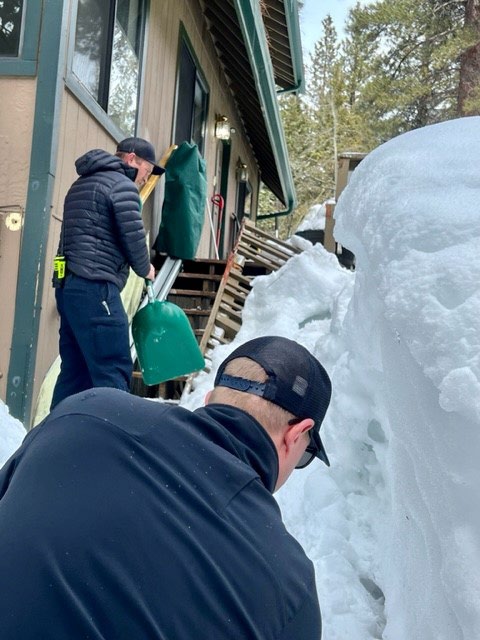Know Before You Throw
March 27, 2023 | Member Submitted
Press release from North Lake Tahoe Fire Protection District.

The winter that keeps on giving is still alive and well! While we are hoping with the official arrival of Spring that we will see the sun more than snow, until then, “Know Before You Throw.”
Taking advantage of breaks between storms is the best opportunity for snow clearing preparations.
Quick Tip Reminders:
• Look up! Snow accumulations can fall and harm/kill you, depending on their size. Clear roofs of excessive snow and ice buildup, being careful not to damage vents and electrical supplies to the building. Clearing the roof can be dangerous so residents are advised to leave this work to professionals (see OHSA Safety Advisory here).
• Be aware that a roof may collapse with little or no warning. The following warning signs could indicate that you have a danger of roof collapse. You should immediately evacuate the building and notify your local building official, fire department, or contact a structural engineer to determine if the building is safe if you observe the following:
- severe or new roof leaks.
- cracked or split wood members.
- bends or ripples in metal supports.
- recent cracks in walls, gypboard or masonry.
- cracks in welds of steel construction.
- sprinkler heads pushed down below ceiling tiles.
- doors that pop open.
- doors or windows that are difficult to open.
- bowed utility pipes or conduits attached to the ceiling; or creaking, cracking, or popping sounds.
• Look down! Keep all exits clear of snow, so that occupants can escape quickly if a fire, or other emergencies, should occur. Keep in mind that windows should be cleared to allow a secondary means of escape in case the primary means of escape is blocked by fire. Keeping exits clear also allows emergency workers to gain access to your building.
• Look all around! Keep all chimneys and vents clear to prevent carbon monoxide from backing up into the building. Some vents, such as pellet stove vents, may exit the building through a wall and are susceptible to being blocked by excessive snow buildup.
We have seen a significant increase in gas leaks, Carbon Monoxide (CO) alarms, and other hazard-related emergencies resulting from repeated storms and heavy snow.
• Know where your gas meter shed is located and keep it clear. Buildup of snow around natural gas meters and piping, as well as falling ice and snow from rooftops, can create hazards for natural gas customers. Promptly clear snow or ice build-up around meters. Use a broom, not a shovel, whenever possible to avoid causing damage. Keep rooftop areas above natural gas meters and piping clear of ice, icicles and/or falling snow to prevent damage.
• Make sure you have working CO alarms installed in a central location outside each sleeping area and on every level of the home. Test them monthly. If your utility vents are located on the side of your home, make sure to keep them clear as snow accumulation can cause carbon monoxide to back up into the house.
Hopefully following these safety tips will help to alleviate potential winter weather related situations.
